Rithika Merchant: At The Dusk of Identity by Decadence Darling
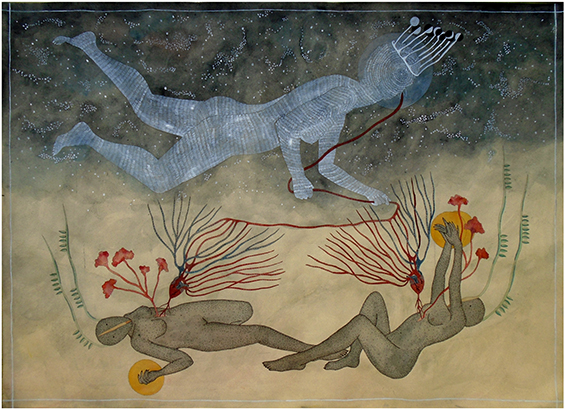
The Moon Devours Her Children, 2015 | 20 x 27.5 in | Gouache and Ink on Paper
Rithika Merchant: At The Dusk of Identity by Decadence Darling
Division requires a line whereby our minds process an object or concept not based on its entirety but upon independent qualities separated from the wholeness. Spirituality in its varied traditions throughout time is essentially to realize how you identify independently from the wholeness, while simultaneously crossing those intellectual lines of division to identify as part of the wholeness. It is a process of unifying duality while maintaining individuality. It is a process where one will find darkness in the light and light in the darkness. That glowing spectral satellite in the night sky reveals a host of mysteries beyond the shadows, it reveals the partitions within our psyche. It is that relationship with our individual mind and the wholeness of the universe that Luna Tabulatorum establishes a narrative to explore how natural phenomena has an effect on humanity and how division is both instituted and transcended.
Inspired by ancient mythology and religions the works of Luna Tabulatorum pays homage to classical lunar archetypes by removing the lines that divide time and culture in the form of iconography, and fashions contemporary allegories that reflect Rithika Merchant’s personal individuation. As the artist explains, “Even though I am interested in myth and stories from the outside world, I use a lot of my own personal symbolism and my personal visual vocabulary in my work and essentially it is my perspective on these existing ideas.”
Rithika has created a contemporary mythos that places a woman, the moon, as the protagonist of the narrative. “So few stories are told from a woman’s perspective and/or place women as the protagonist.” Her work opens “up a discussion about how women are viewed within society and the role that they are often forced to play.” Historically it has been through myth that women are liberated from social roles, albeit, their mythical depiction is often demonic. The witch is a woman divinely connected to a realm beyond the material, and is therefore above the social construct of duality. She does not live by the same laws of good and evil like the ordinary man, and because of this her union with the wholeness is deemed a perversion by those who cannot visualize the greater picture.
The feminine lens through which we view the narrative of Luna Tabulatorum, though subtle, is significant. In the paintings Selenography and Orbiter the feminine lens is most noticeable by the vulva shape in which we view humanity and the universe. Furthermore in Luna Tabulatorum the order of life is not a realist depiction. Lines aren’t straight, bodies are irregular. This is an intuitive perspective showing the creativity of creation, not the science.
“One rarely sees a straight line in nature. The circle is a more organic shape. Circular shapes are also reminiscent of eggs, birth and cosmogony. The straight line and by extension a phallic shape represents causality or viewing a situation as purely getting from one place to the other. The circle by contrast expresses the idea that there is interrelation and more than one way to express an idea. It also holds the sum of many different parts.”
This femininity is further expressed in the color washed paper and the light application of gouache and ink that leaves a stain. The artist controls the space in which to apply the color but the pigment settles in a cloudy impression, making each mark of the brush solely unique. Both line and color define the strength of female intelligence and creativity.
Through her paintings Rithika is inviting us to look deeper into our feminine nature. But what does feminine mean? Going beyond the behavioral characteristics we associate with being feminine, and referring to the nature of the moon, we can begin by associating the feminine with darkness. Now, what does darkness mean? Due to misunderstanding the mysteries of darkness many women have been persecuted due to this association, as it was and still is with witches.
In the painting The Moon Devours Her Children the relationship between corporeal form and the unbound cosmos depicts how the universe is living and personable. The organs of the humans are externalized and branch out into the universe, showing that our true life force is linked to the universe. However, in this particular painting the moon withdraws the life force, thus representing the moon as destructive. Light is associated with life, and therefore night, which brings an end to light, is associated with death. But without night, without death, there would be imbalance. This malefic feature of darkness is what people fear, and out of fear they feel they need to protect themselves from darkness, rather than embrace it.
In Queen of Life and Death, a bird carries crowned Death into the air. The bird is an animal that can go from the ground to the air at will and is therefore transcendental to the laws that bind other creatures to the earth. This connection with limitlessness symbolizes death as a transcendental process. This painting is the moonlight of Rithika’s narrative that illuminates the hidden nature of the darkness of Luna Tabulatorum, for now our perspective shifts to a broader lens as we realize that death is at its lowest point a grotesque biological process, and at its highest point spiritual emancipation, and somewhere in the middle it is the catalyst for transformation. Death becomes light.
Life becomes dark. The creative side of female nature is inherently dark as it is internal, but it is within the darkness of the womb that life is manifested. That same darkness that was once malefic is now benefic. As shown in Genesis it is through the blood sacrifice of menstruation that woman creates life. Mystical traditions have taken this biological phenomenon to understand how all individuals must enter an internal state of darkness and to make internal sacrifices to create their manifest destiny. The microcosmic human experience of fertility and the process of birth is projected philosophically in order to understand the macrocosmic universe.
“I have found that often creation comes from a dark place, which is why I find creation myths so compelling. These myths are found in almost all human cultures. There are numerous myths and ideas which speak of creation by the dismemberment or out of some body part or fluid of a primordial being.”
The pentagram pointing upward signifies invoking divine power down into the material elements, or pointing downward signifies evoking divinity from within the elements. Evoking divine power within/below oneself has been classified as evil, for it is posited that divinity should be invoked from above/outside oneself. Rithika expresses the concept of power from the higher Divine/masculine reflecting in the lower Material/feminine, much like the moon receiving light from the sun, by crowning her subjects and illuminating their hands and feet with halos. Notice those symbols of divinity are circular and recall what Rithika previously mentioned about circles.
“The use of crowns and halos are to draw attention to the importance and power of a character rather than its divinity. For me putting halos on the hands and feet of the beings is all about elevating and making their actions divine or powerful.”
Through deconstruction, revolutions, and transfigurations the individual experiences an identity crisis. The divisional lines between body, mind, and spirit begin to evaporate. In Lunatic, the individual is tangled by multiple personalities learning how to balance their natures.
Lyconography shows us we need not fear our animal nature but to embrace it, for divine works can be made. It is by denying this animal nature that we divide our self and identify with only the aspects we do not fear, thus separating our identity from the wholeness of our being.
“The Moon teaches us to balance different aspects of our personality. It teaches us that to be whole we have to accept the darker side of our selves—be it the destructive aspects or the more taboo (as judged by society) aspects of ourselves.”
The answer to spiritual emancipation has always been right above us in the night sky. When we learn to unify our spirit to our mind and our mind to our nature, our bodies become the painting the Divine Receptacle. We become a vessel for amrta, the nectar of the gods, for which the universe is sustained. Rithika
Merchant’s Luna Tabulatorum curves those straight lines of division within our mind and transmits light to the darkest aspect of our being—our Self. Luna Tabulatorum is the illumination of Self undivided by identity, nor eclipsed by the narrative of scientific enlightenment.
“In modern times and for the foreseeable future, science gives us a complete explanation for most things. However, it places humans as part of a greater scheme rather than the centre of our own narrative. As much as science gives a more accurate description of humanity it takes away the spiritual power given to every human to understand their own destiny. The moon and its legends and symbolism allow us try to bring humanity back to the centre of concern.”
.jpg)
Sacred Moon (FertileCrescent), 2015 | 20 x 27.5 in | Gouache and Ink on Paper
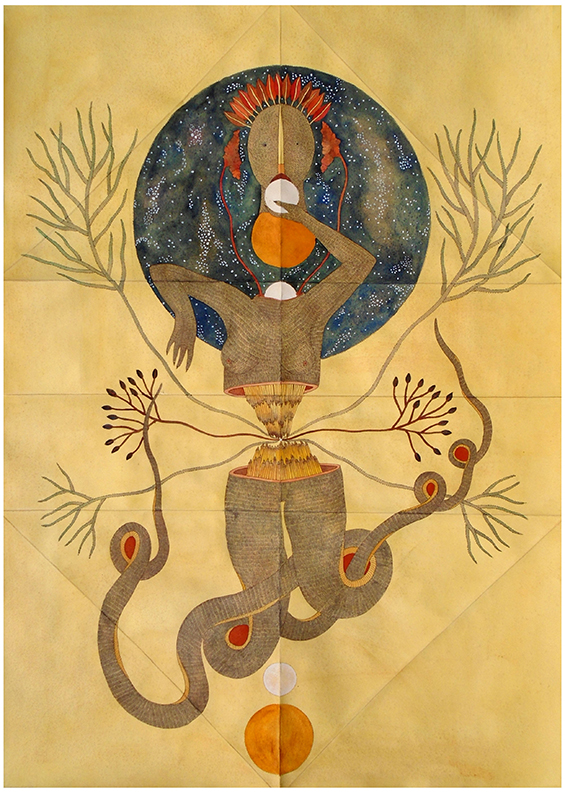
Syzygy, 2015 | 27.5 x 20 in| Gouache and Ink on Paper
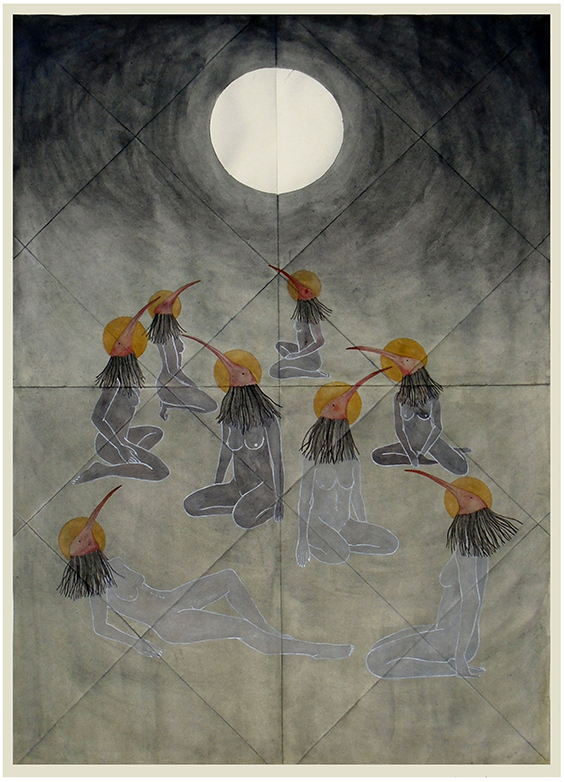
Time Keeper, 2015 | 39 x 27.5 in | Gouache and Ink on Paper
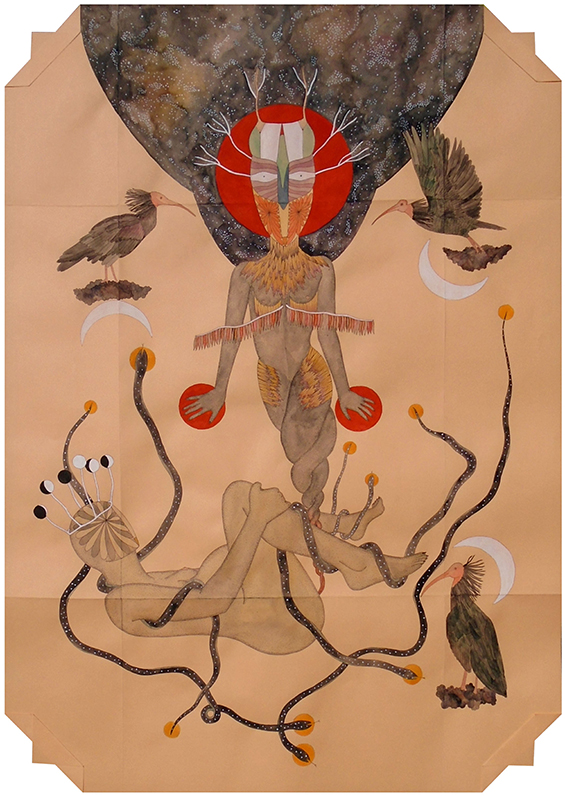
Lilith Births The Djinn, 2015 | 39 x 27.5 in | Gouache and Ink on Paper
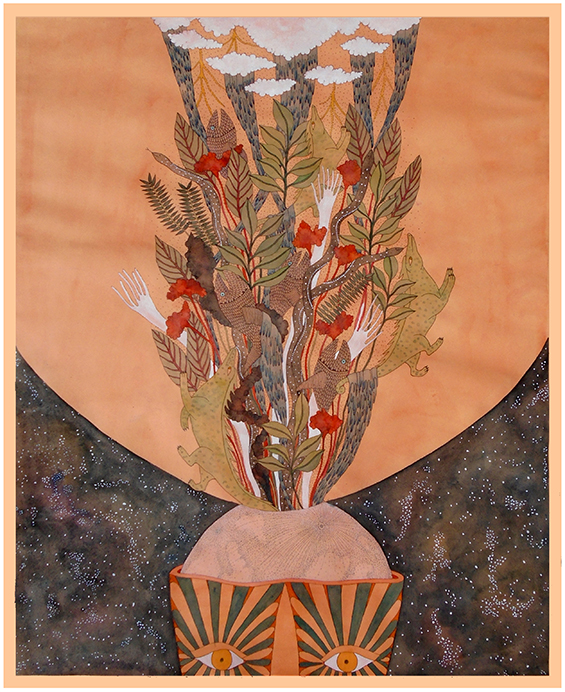
Divine Receptacle, 2015 | 23.6 x 20 in | Gouache and Ink on Paper
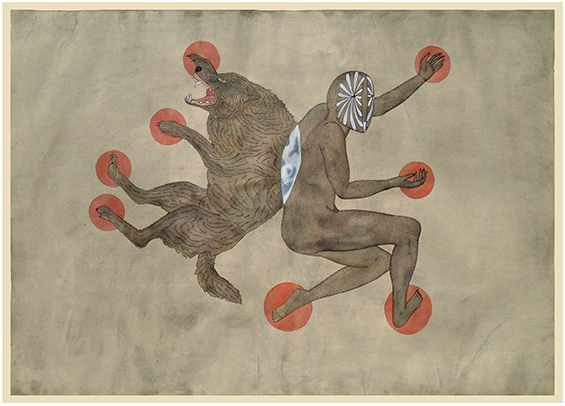
Lycanthropy, 2015 | 20 x 27.5 in| Gouache and Ink on Paper
.jpg)
Queen of Life and Death, 2015 | 21 x 17 in | Gouache and Ink on Paper
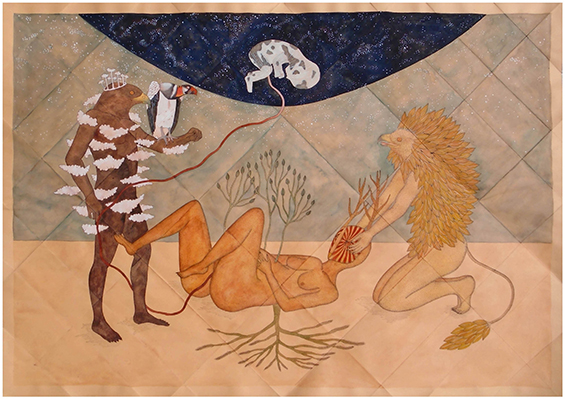
Genesis, 2015 | 27.5 x 39 in | Gouache and Ink on Paper
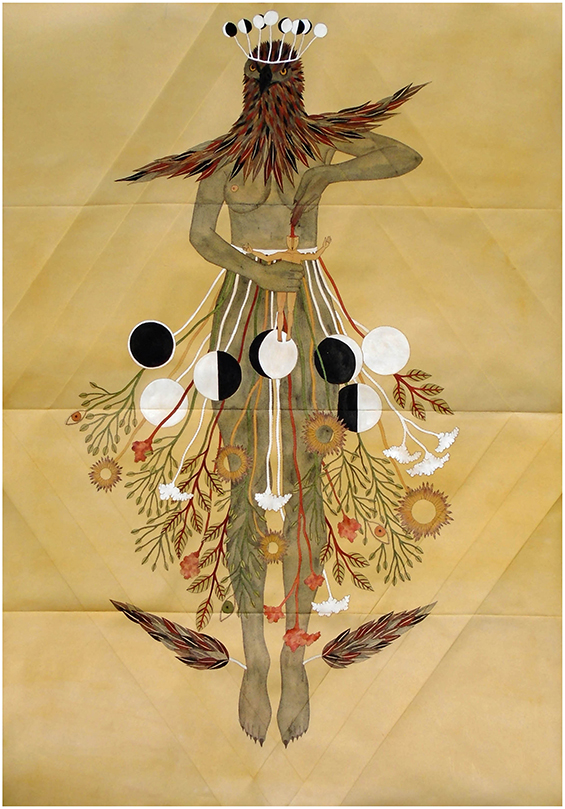
High Priestess, 2015 | 39 x 27.5 in | Gouache and Ink on Paper
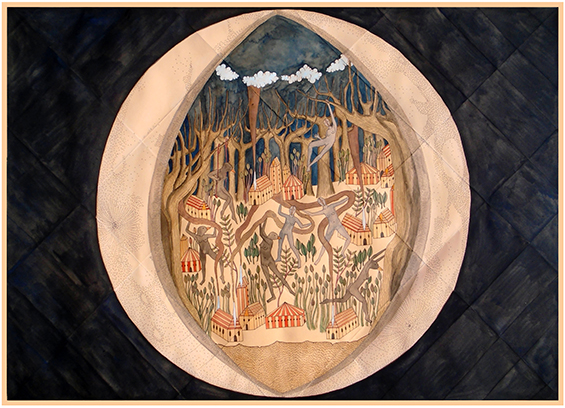
Orbiter, 2015 | 20 x 23.6 in | Gouache and Ink on Paper
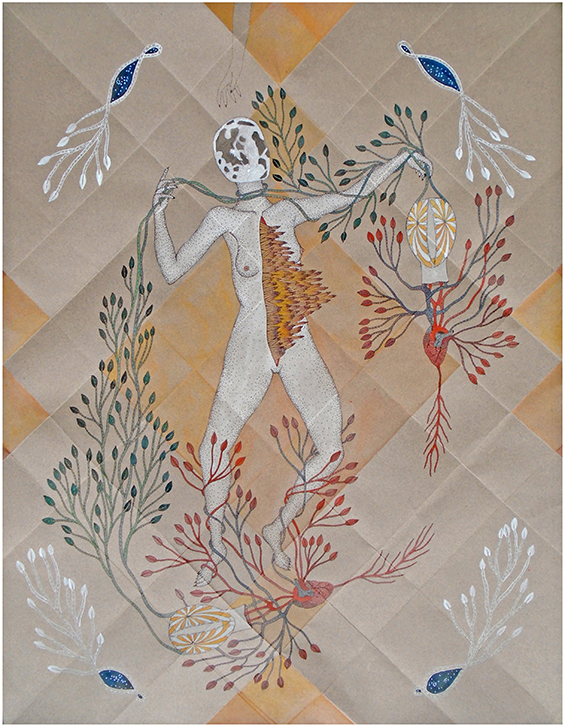
Lunatic, 2015 | 23.6 x 20 in | Gouache and Ink on Paper
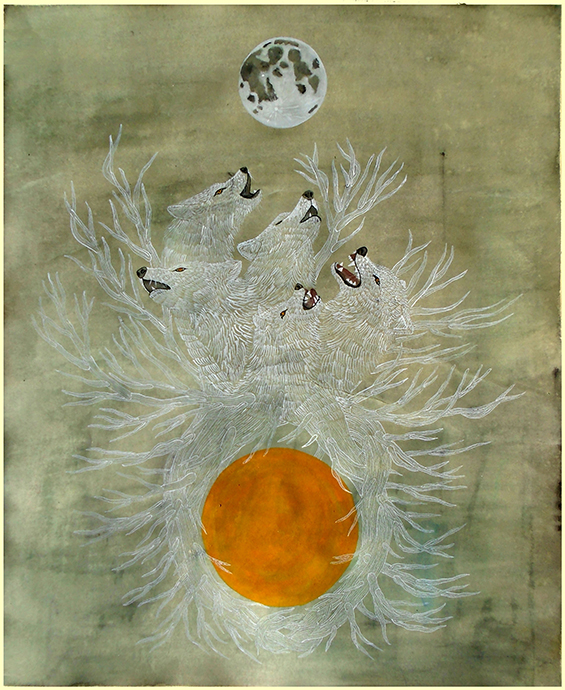
Howl, 2015 | 23.6 x 20 in | Gouache and Ink on Paper
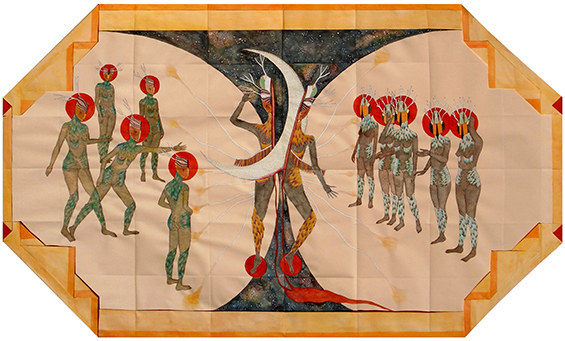
Council of Choice , 2015| 20 x 33. 4 in | Gouache and Ink on Paper
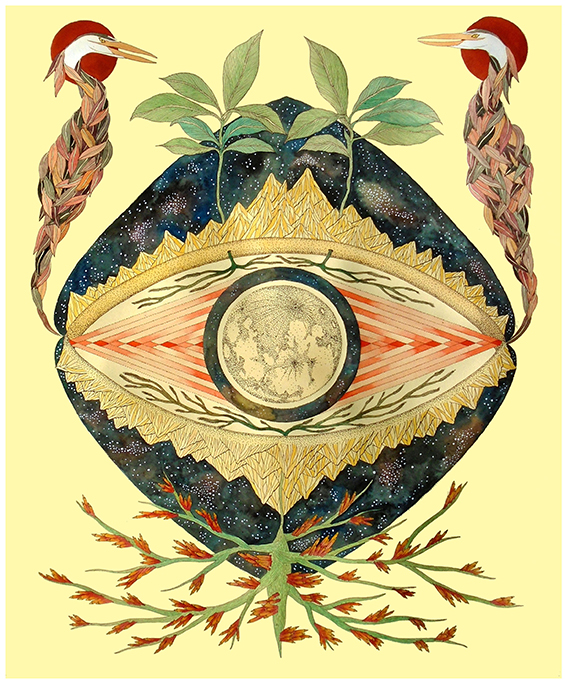
Selenography, 2014 | 23.6 x 20 in | Gouache and Ink on Paper
Decadence Darling explores the esoteric elements of chaos, death, and transformation in art, philosophy, and society as a means to redefine our understanding of darkness. Through written word and conducting interviews with artists such as Kazuhiro Tsuji and El Gato Chimney his work has been published online and in literature in Beautiful Bizarre Magazine, as well as his personal blog, “Manifesto of Decadence”.
RITHIKA MERCHANT “LUNA TABULATORUM”
September 3 – October 15 2015
Stephen Romano Gallery, Brooklyn New York
www.romanoart.com
